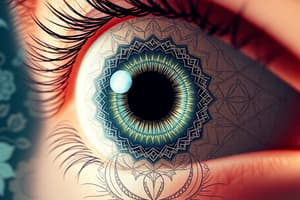Podcast
Questions and Answers
What is the primary aim of corneal topography?
What is the primary aim of corneal topography?
- To obtain detailed data about corneal curvature (correct)
- To evaluate the thickness of the retina
- To measure intraocular pressure
- To assess the overall health of the eye
Which surface of the cornea has the greatest refractive power?
Which surface of the cornea has the greatest refractive power?
- Posterior Surface
- Limbal Zone
- Peripheral Zone
- Anterior Surface (correct)
What is the average radius of curvature of a healthy cornea?
What is the average radius of curvature of a healthy cornea?
- 7.0 mm
- 7.8 mm (correct)
- 8.0 mm
- 6.5 mm
How much light does a healthy cornea scatter from the incident light?
How much light does a healthy cornea scatter from the incident light?
What is the thickness of the cornea at its center?
What is the thickness of the cornea at its center?
What is the diameter of the Central Zone of the cornea?
What is the diameter of the Central Zone of the cornea?
Which instrument is designed to quantitatively measure the radius of curvature of the cornea?
Which instrument is designed to quantitatively measure the radius of curvature of the cornea?
What characteristic is associated with the Peripheral Zone of the cornea?
What characteristic is associated with the Peripheral Zone of the cornea?
Which of the following is a psychological application of corneal topography?
Which of the following is a psychological application of corneal topography?
Which principle does most topographers rely on to capture the image of the cornea?
Which principle does most topographers rely on to capture the image of the cornea?
Flashcards are hidden until you start studying
Study Notes
Corneal Topography: Definition and Aim
- Studies the shape of the corneal surface.
- Aims to provide detailed, accurate data on corneal curvature in a clinically useful format.
Corneal Refractive Power and Dimensions
- Contributes 43 diopters (70%) of the eye's refractive power.
- Average radius of curvature: 7.8 mm.
- Anterior surface horizontal diameter: 11.75 mm; vertical diameter: 11 mm.
- Posterior surface diameter: 11.5 mm.
- Total corneal refractive power: +43.00D (anterior surface: +48.00D).
- Central corneal thickness: 0.52 mm; peripheral thickness: 0.67 mm.
- Healthy cornea scatters approximately 10% of incident light, mainly due to stromal scattering.
Corneal Zones and Geography
- Central Zone: Spherical, 3.6 mm diameter.
- Paracentral Zone: Ring with 7.8 mm outer diameter and 3.4 mm width; progressively flattens (prolate).
- Peripheral Zone: Outer diameter of 11 mm; greatest flattening and asphericity.
- Limbus: Average diameter 12 mm; cornea steepens before scleral junction. Includes pupil border and limbal zone.
Corneal Topography Instruments
- Keratometer: Measures radius of curvature of 3 mm corneal zones.
- Keratoscopy/Photokeratography: Qualitatively evaluates reflected light on the corneal surface.
- Computerized Videokeratography: Measures larger corneal areas with more data points, providing permanent records.
Applications of Corneal Topography
- Contact lens fitting.
- Diagnosing corneal irregularities (keratoconus, ectasia, dystrophies, scars).
- Managing refractive surgery patients.
Basic Topographic Principles
- Principle of Reflection: Image captured via reflection from a thin corneal layer, which reflects the surface shape and allows height measurement of each point. This technique can amplify topographic distortions.
- Placido Disc-based Topographers: (Note: Details on this and other principle types (Elevation Based System/Direct Triangulation System, Principle of Projection) are not provided in the text).
Studying That Suits You
Use AI to generate personalized quizzes and flashcards to suit your learning preferences.



